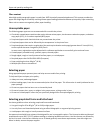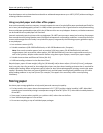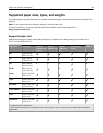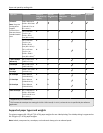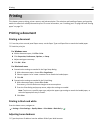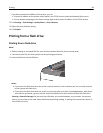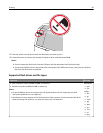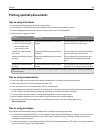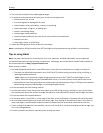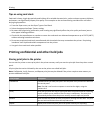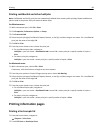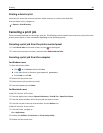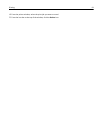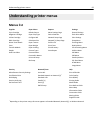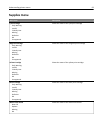
Printing specialty documents
Tips on using letterhead
• Use letterhead designed specifically for laser printers.
• Print samples on the letterhead being considered for use before buying large quantities.
• Before loading letterhead, flex the sheets to prevent them from sticking together.
• Observe proper page orientation.
Source Print side Paper orientation
– Standard 550‑sheet tray
– Optional 550‑sheet tray
– Optional 2000‑sheet
high‑capacity feeder
Preprinted letterhead design is placed
faceup.
The top edge of the sheet with the logo is
placed at the left side of the tray.
Duplex (two‑sided) printing
from trays
Preprinted letterhead design is placed
facedown.
The top edge of the sheet with the logo is
placed at the right side of the tray.
Multipurpose feeder (simplex
printing)
Preprinted letterhead design is placed
facedown.
The top edge of the sheet with the logo
should enter the multipurpose feeder
first.
Multipurpose feeder (duplex
printing)
Preprinted letterhead design is placed
faceup.
The top edge of the sheet with the logo
should enter the multipurpose feeder last.
Note: Check with the manufacturer or vendor to determine whether the chosen preprinted letterhead is acceptable
for laser printers.
Tips on using transparencies
• Print a test page on the transparencies being considered for use before buying large quantities.
• Feed transparencies from the multipurpose feeder only.
• From the Paper menu, set the MP Feeder Type to Transparency.
• Use transparencies designed specifically for laser printers. Transparencies must be able to withstand temperatures
of 230°C (446°F) without melting, discoloring, offsetting, or releasing hazardous emissions.
• To prevent print quality problems, avoid getting fingerprints on the transparencies.
• Before loading transparencies, flex the stack to prevent sheets from sticking together.
• We recommend Lexmark transparencies. For ordering information, see the Lexmark Web site at
www.lexmark.com.
Tips on using envelopes
Print samples on the envelopes being considered for use before buying large quantities.
• Use envelopes designed specifically for laser printers. Check with the manufacturer or vendor to ensure that the
envelopes can withstand temperatures up to 220°C (446°F) without sealing, wrinkling, curling excessively, or
releasing hazardous emissions.
• For best performance, use envelopes made from 90‑g/m
2
(24‑lb bond) paper or 25% cotton. All‑cotton envelopes
must not exceed 70‑g/m
2
(20‑lb bond) weight.
Printing 86



